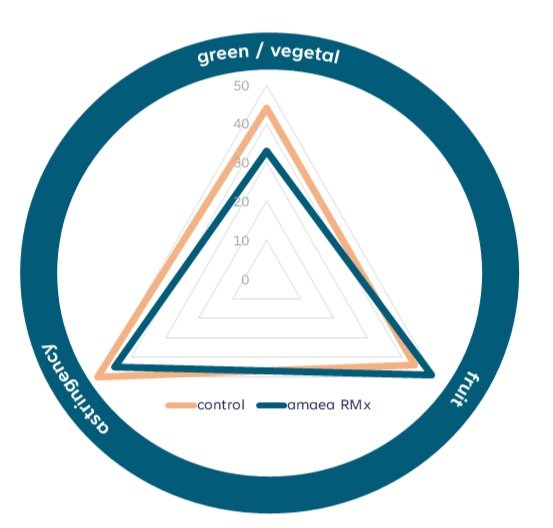Battling green aromas in wine
Pyrazines are a class of compounds naturally found in grapes that lend a “green” or “vegetal” aroma to certain wines, like Cabernet Sauvignon. A small amount of pyrazine can act as a regional hallmark at low concentrations but at higher levels it can distract as an oppressive note that obscures desired fruit aromas. To avoid the latter impacts, growers might elect to expose grapes to more sunlight and heat, but in recent years, unpredictable heat waves and intense sunlight have led to berry damage. Growers and winemakers alike are having to balance the risks of green aromas against loss of overall quality due to sun and heat damage.
IBMP (isobutyl methoxypyrazine) is the primary pyrazine which is easily identified in some wines and is most associated with immature grapes[1,2,3].
Since winemakers have lots of factors to consider at harvest, such as impending rains or elevated disease pressure, some wines will inevitably come in with green aromas every year.
Winemakers currently address this issue with advanced winemaking techniques to shift the sensory profile to be more fruit-forward. These methods can significantly add to production costs, as adjuncts or extra barrels might be required.
Recently, amaea launched amaea RMx, a commercial pyrazine removal treatment process developed in conjunction with their industry research partner.
In a recent trial using Cabernet Sauvignon from Sonoma County, California, IBMP was used as the analytical marker and had showed a reduction of 23 percent (Figure 1.), lowering the green sensory impacts, and allowing more of the varietal fruit characters to shine through.
IBMP Concentration (ng/L)
Sensory Evaluation
Figure 2. Sensory evaluation from 2022 Cabernet Sauvignon from Sonoma County, California.
amaea RMx is a unique remediation solution for pyrazines that gives winemakers a new tool to address pyrazines in wine production. Using amaea RMx streamlines your process with targeted pyrazine removal, avoiding extra cellar time for trials or exploration with additives to mask unripe flavors from a challenging harvest.
Learn more about amaea RMx and our ability to remove pyrazines from wines today.
Author: Torey Arvik, VP of Applied Research
References:
Lacey, M.J, M.S. Allen R.L.N. Harris, and W.V. Brown. 1991. Methoxypyrazines in Sauvignon blanc grapes and wines. Am. J. Enol. Vitic. 42:103-108
Boulton, R.B., V.L. Singleton, L.F. Bisson and R.E. Kunkee, “Principles and practice of winemaking”. Chapman & Hall, New York, NY, 1996.
https://daily.sevenfifty.com/the-science-of-pyrazines-in-wine/


